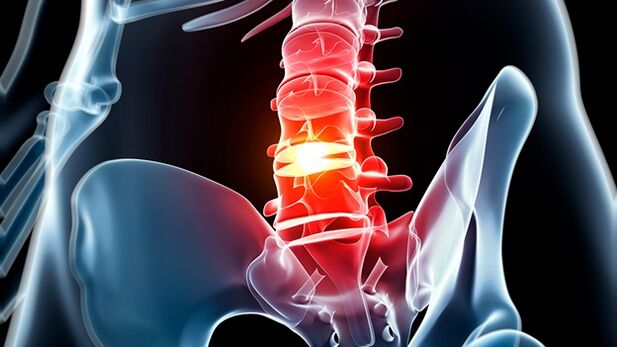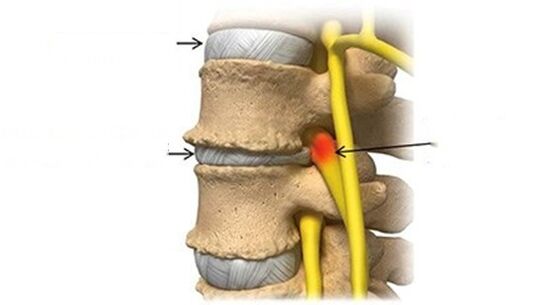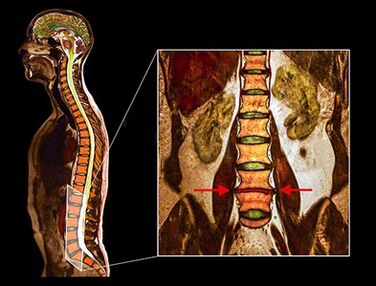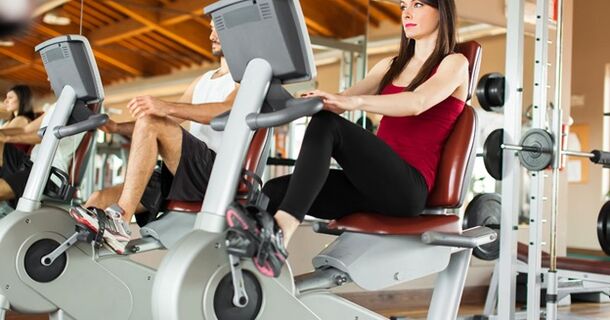Osteochondrosis (degenerative disk disease) in the lumbar column or the lumbar area is caused by involutive changes in the discs, which causes low back pain.
Intervertebral discs are resistant fibrous structures that act as ligaments between vertebrae, absorbing the impacts and providing absorption of column impacts.The discs are flexible but strong enough to facilitate movements such as folding the torso forward, back or on the sides.
Despite the name, osteochondrosis is not considered a true disease and symptoms do not usually get worse over time.The discs, like all the structures of the body, degrade as we age and the degeneration of the disc is developed in all people as part of the involutive process.
A characteristic feature of osteochondrosis is a gradual decrease in symptoms as the column begins to stabilize.The treatment of the degenerative disease of the lumbar column disk focuses on minimizing pain, stabilizing the column and improving or maintaining mobility.
Symptoms

Most cases of manifestation of osteochondrosis of the lumbar spine consist of the presence of mild and constant back pain, which intensifies from time to time for several days or more.
Symptoms may vary, but the most common include:
- Moderate and constant pain in the lower back.The pain in the damaged disc area is the most common symptom of disk degeneration.The pain can radiate to the buttocks, the groin and the upper part of the thighs.This pain is usually deaf and its intensity can vary from slight to severe.
- Pain acute episodes.Back pain can get worse for a few days or weeks and then return to a slighter level.Pain outbreaks occur as the column degenerates and decreases as the column gradually stabilizes.Pain outbursts can occur suddenly and pain often leads to a decrease in mobility.
- Local pain.The lower back area surrounding the degenerate disc may be sensitive to touch.The local pain is caused by inflammation and muscle tension in the area of the disk damaged by degeneration.
- Leg pain.Neurological symptoms, which include numbness, weakness or acute pain, shooting pain in the buttocks, hips and / or the back of the leg, can be felt if the height of the disc is significantly reduced and the conditions for the compression of the nerve root arise.The pain in the legs with osteochondrosis of the lumbar column generally does not fall under the knee.
- A feeling of sudden weakness or instability can occur with a significant weakening of the disk and the patient believes that the lower back is incompletely performing its functions.
In addition, pain can be intensified or decreased when performing some movements or certain poses, such as:
- Pain in the seat.Sitting for long periods often causes greater back pain and rigidity and decreases after emerging or changing position.
- Strengthen pain with inclination or rotation.Torcir the column and lean forward, back or sideways can cause intense pain on the damaged disk.
- Reduce pain when walking or changing position.When the column changes the position, the pressure on the discs decreases or redistributes from discs to muscles and joints.Frequent positions, alternating standing and sitting, as well as short walks can help reduce rigidity and minimize pain.
The degeneration of the disk should not cause symptoms of intestinal dysfunction / bladder, fever with back pain, inexplicable weight loss and intensive abdominal pain.These symptoms indicate more serious conditions and often require operational treatment methods.
Associated symptoms
With the osteochondrosis of the lumbar column, in addition to lumbar pain, other symptoms associated with the degeneration of the disc.For example:
- The proteins contained within the disc can cause significant inflammation if they come into contact with the surrounding spinal structures, and this inflammation can lead to spasms of the lower back muscles, as well as radial pain, with radiation to the hips and the posterior surface of the lower extremities (also called Ishias).
- Lumbar disc degeneration can contribute to the development of lumbar stenosis and / or lumbar osteoarthritis, as well as other lower back conditions.
- A degenerate album can also lead to the appearance of a hernia of the lumbar intervertebral disc.Neurological symptoms with an album hernia can be acute and intense.
- The symptoms caused by the degeneration of the disk in the lumbar column can vary widely depending on how fast or completely the disc has suffered degeneration and how it affects the surrounding spinal structures.
- The pain by osteochondrosis is generally caused by the deformation of the muscles that support the spine and inflammation around the structures close to the disc.
The causes of the lumbar column osteochondrosis
Osteochondrosis occurs due to the wear and tear of the disk structure, and the degeneration process can accelerate due to injuries, general condition, health and lifestyle, and, possibly, a genetic predisposition to the development of pathological processes in the musculoskeletal system.

Osteochondrosis begins with a serious injury, such as a car accident.The beginning of degenerative processes is more likely associated with a low -energy disc injury.
The pain of law associated with lumbar osteochondrosis is generally generated by one or more pathological processes:
- Inflammation, disc proteins are irritated by the surrounding nerves, both small nerves in the disc itself and the potentially large nerves that go to the feet (sciatic nerve).
- The abnormal instability of the micro, when the external rings of the disc, called fibrous ring, wears out and cannot effectively absorb power vectors in the spine, which leads to movements along the vertebral segment.
- For a long period of time, pain in the osteochondrosis of the lumbar column finally decreases, and does not get worse.This pain relief occurs because the album completely damaged by degeneration no longer has inflammatory proteins (which can cause pain) and the sleeping disk passes to a stable position, eliminating the micro-moving that causes pain.
Risk factors
Lifestyle factors that affect the general state of health can affect intervertebral discs.The risk factors of a degenerative disk disease (osteochondrosis) include:
- Family history of back pain or skeletal and muscular disorders
- Excessive load at the bottom of the back, due to sports or the nature of work
- Long static loads on the discs due to prolonged seats and / or a bad posture
- Lack of disc support due to weak back muscles
- Obesity
- Smoking or any form of nicotine consumption
The degeneration of the disc is part of the aging of the body, but not all people develop pain or no special symptom.The symptoms tend to occur in case of instability, muscle tension and, possibly, irritation of the nerve root.
Diagnosis
- The history of the disease includes a detailed study of symptoms in the patient, their intensity and the relationship of pain with loads or body position.Information about regular physical activity, sleep habits and past injuries are also needed.
- A physical examination is necessary to study the range of movements and the state of the muscle corset.The presence of painful areas on palpation or physical abnormalities is also determined.In addition, neurological tests are performed to determine a neurological deficit.
- The above diagnostic methods are usually enough for the diagnosis of osteochondrosis, but a precise diagnosis requires the use of visualization methods.
- Connecticut
- Radiography
- MSCT
- PAT
- MRI: This diagnostic method allows you to clarify the degree of degeneration, the presence of fractures, stenosis discs.Often, a magnetic resonance study is necessary in preparation for surgical treatment to accurately determine the location of the degenerate disc and plan the operation.

Studies have shown that the results of magnetic resonance with degeneration of moderate or significant disks are found when exploring patients, both with at least severe pain or lack of pain.In addition, many painful conditions may not appear in a magnetic resonance.For this reason, the diagnosis cannot be done exclusively on the basis of the results of the visualization, and the verification of the diagnosis is possible only on the basis of all the methods of clinical and instrumental examination.
Treatment
The initial methods to treat the osteochondrosis of the lumbar column and the manifestations of pain generally include the following combinations:
- Overcomplexion analgesics They can reduce inflammation, which contributes to the discomfort, stiffness and irritation of nerve roots.
- Prescription painkillers.In severe pain, muscle relaxants or narcotic analgesics can be prescribed.These medications are generally used to treat intensive and acute pain, which is expected to last more than a few days or weeks.These drugs can cause addiction and cause serious side effects, so they should be used with caution.
- Heat and ice.The use of heat in the lower back improves blood circulation, which reduces muscle cramps and tension and improves mobility.Ice packages can reduce inflammation and relieve moderate pain.It is useful to use heat before physical exercises to relax muscles and use ice after physical activity to minimize inflammation.
- Manual therapy. The manipulation of which a specialist carries out is a popular method of pain in low back pain.Practical doctors, manual therapists, use their hands to influence several areas of the body to reduce tension in muscles and joints.It was discovered that manipulations are an effective measure for temporary pain reduction, and in some cases it is as effective as pharmacological therapy.
- Massage.Exposure by massage methods can reduce tension and cramps in the lower back muscles, reduce the pressure on the column and relieve pain.In addition, therapeutic massage can improve blood circulation, ensuring the supply of nutrients and oxygen to tense muscles.
- Epidural steroid injections.The introduction of steroids in the space surrounding the column can reduce pain impulses, as well as inflammation.Steroid injection can be used in combination with the physiotherapy program to relieve pain during physical exercises and rehabilitation.As a general rule, the epidural injection of steroids allows to reduce pain in a period of several weeks to one year.
In many cases, for effective anesthesia, a combination of treatment methods is needed.The process of trial and error, as a rule, is necessary to choose a treatment that turns out to be the most effective.
Rest is not recommended long bed and, as a rule, immobilization is possible with severe pain for a short period of time, since the lack of physical activity can lead to the weakening of the muscles and the normal support of the spine.
Activity exercise and modification therapy

To maintain a healthy mobility of the spine, physical exercises are needed.An effective exercise program for the lumbar column should include:
- Exercises to stretch the muscles of the lower back, hips and pelvis, as well as the muscles of the back.The seal of these muscles increases pressure on the lumbar spine and contributes to the development of low back pain.
- The power exercises in the muscles of the lower back and the abdomen allow it to maintain a good posture and it is better to keep the spine.The exercise program to strengthen the muscles can include an individual exercise therapy program, dynamic stabilization of the lumbar column, tai-chi, pilates or others.
- Aerobic exercises with a low level of load, which increase the frequency of cardiac contractions, improve blood circulation and provide nutrients and oxygen, which is necessary to restore body tissues.For example, it can be walking aerobics, swimming and water.
Physical exercise programs generally adapt in each case, depending on the general state of health, the severity of pain and personal preferences.
In addition, small adjustments to daily activity (lifestyle modification) can effectively soften pain.For example, dressing a corset when lifting weights or avoiding twisting when lifting weights can avoid greater pain due to excessive loads on the discs.The use of an ergonomic chair and an orthopedic mattress can also improve posture and reduce the load on the discs.
Surgical treatment
The surgical treatment of the osteochondrosis of the lumbar column is necessary in cases where conservative treatment for 6 months was inefficient.Surgical treatment for osteochondrosis is always selective, which means that the patient himself decides whether the operation should suffer or not.
It is recommended to take into account all factors before deciding an operation for osteochondrosis, including the duration of the recovery period, pain treatment during the recovery and rehabilitation of the spine.
The mergers of the vertebrae
The standard surgical treatment of the lumbar spine osteochondrosis is a fusion surgery in which two vertebrae together are spent together.The purpose of mergers (spondilode) is to reduce pain and eliminate instability in the spine motor segment.
All spinal fusion operations are as follows:
- The damaged album is completely eliminated from the intervertebral space (discoctomy).
- The stabilization is carried out using a bone transplant and / or tools (implants, plates, rods and / or screws).
- Then, the vertebrae merges, forming a solid and motionless structure.The fighting occurs within several months after the procedure, and not during the operation itself.
After the operation, a corset is prescribed, taking analgesics.The exercises are very careful, taking into account the individual characteristics of the patient and the degree of tissue regeneration.The complete recovery after the merger can take up to a year until the vertebrae grows together.
Surgical replacement of an artificial disc
Replacing the damaged album with an artificial implant has been developed in recent years as an alternative to mergers.The disk replacement operation is to completely eliminate the disk damaged by degeneration (discoctomy), the restoration of the disk space at the natural height and the implementation of the artificial disc.
This procedure is designed to maintain movement in the column similar to natural movements, reducing the probability of increasing pressure in neighboring spinal segments (quite common complications of spinal fusion).
Recovery after the replacement operation of the disc generally lasts up to 6 months.






















